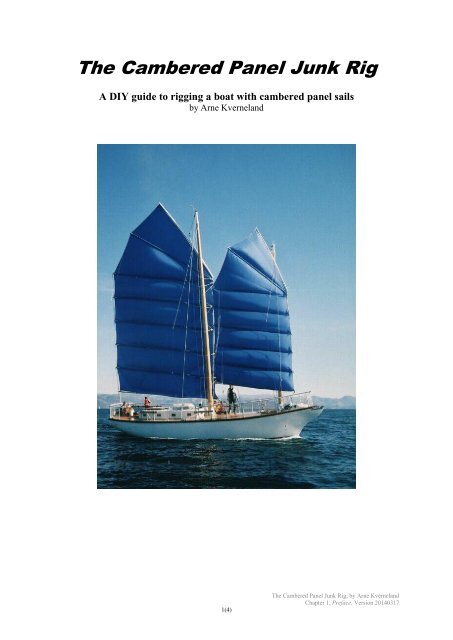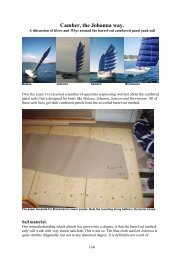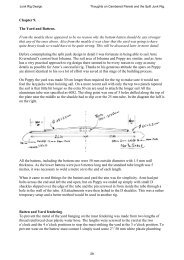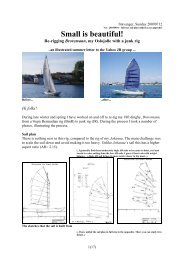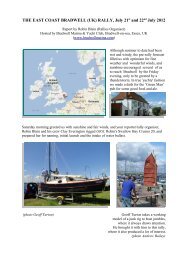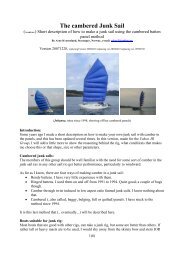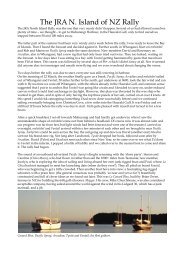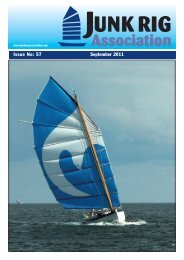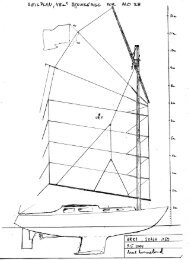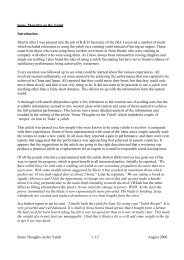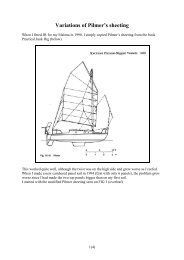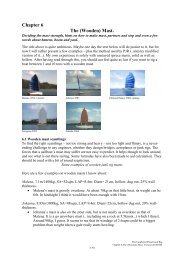The Cambered Panel Junk Rig - The Junk Rig Association
The Cambered Panel Junk Rig - The Junk Rig Association
The Cambered Panel Junk Rig - The Junk Rig Association
Create successful ePaper yourself
Turn your PDF publications into a flip-book with our unique Google optimized e-Paper software.
<strong>The</strong> <strong>Cambered</strong> <strong>Panel</strong> <strong>Junk</strong> <strong>Rig</strong>A DIY guide to rigging a boat with cambered panel sailsby Arne Kverneland1(4)<strong>The</strong> <strong>Cambered</strong> <strong>Panel</strong> <strong>Junk</strong> <strong>Rig</strong>, by Arne KvernelandChapter 1, Preface, Version 20140317
Chapter 1: PrefaceList of contentsI guess this “book” one day will contain these chapters:1. Preface.2. <strong>The</strong> boat - finding a suitable boat to buy, build or have built.3. Choosing a sailplan - finding the balance and other practical considerations4. Drawing a detailed sail. Includes a set of ten CAD-generated master sails5. Making the sail(s); real cutting in canvas.6. <strong>The</strong> (wooden) mast. Deciding the mast strength. Making mast, steps and partners.7. <strong>Rig</strong>ging the sail. All those ropes! *NS)8. Handling under sail. *NS)9. Miscellaneous, more details, possible improvements. *NS)10. Possible afterthoughts *NS)Note: *NS)= not started(Johanna, mine since 1998, showing off her cambered panels)Why am I writing this?<strong>The</strong> idea is neither to write a new Practical <strong>Junk</strong> <strong>Rig</strong> (PJR, see next page) nor to make a PJRappendix. It is simply to pass on the experience gained after having designed and made a fewjunk rigs myself. <strong>The</strong> goal is to enable you to make your own sail, and maybe even design ityourself. However, I have no ambitions to write a new <strong>Junk</strong> <strong>Rig</strong> Bible where every detail isdiscussed from A to Z. Since I am not a very systematic teacher, I suggest you read througheach chapter a couple of times before you go to work. If it still seems Greek to you, then Isuggest you read one of the books listed below on the subject. You should find that chapter 7on rigging the sail will contain most of the running and fixed ropes you will have to know.(.. or could I suggest you read my 10-page write-up called <strong>Junk</strong> <strong>Rig</strong> forBeginners?..)2(4)<strong>The</strong> <strong>Cambered</strong> <strong>Panel</strong> <strong>Junk</strong> <strong>Rig</strong>, by Arne KvernelandChapter 1, Preface, Version 20140317
Other sources of JR knowledge:To get a better overview of junk rigs I suggest you read some of these books: "Practical <strong>Junk</strong> <strong>Rig</strong>" (PJR) by Hasler and McLeod. (ISBN 0-229-11798 8). This book isvery good! It is at its best when showing you a number of sail plan forms and possible ways offitting sheets, halyards and parrels. In short, it gives you the overview. With PJR in hand Irigged my first JR on Malena without outside help. At that time there was no help availablefrom the Army of Internet Armchair Expertise – the net wasn’t there. Still, PJR is not fully upto date: <strong>The</strong> sails are flat and in my view the wooden masts are over-strong and thus overheavy. "<strong>The</strong> Chinese Sailing <strong>Rig</strong>" by Derek van Loan. A good and practical book. It shows analternative DIY-friendly way of making a pole mast. That alone makes it worth reading – ifyou are to make a wooden mast. ”Easier <strong>Rig</strong>s for safer Cruising” by John Campbell. (ISBN 0-370-30698-8 paperback).A little dated maybe, but gives you a good comparison between different rigs. A good read. <strong>The</strong>re is some useful info on the www too. Be critical though as there are many armchairexperts out there, particularly on the e-groups. Make sure they have tried their solutionsthemselves and have given accurate reports on the results before you jump at them.My learning curve:I’ve fiddled with boats and sails (.. or anything that floated...) for almost as long as I canremember. I made my first sprit sail when I was a teenager back in 1970. During the seventiesI sailed with Bermuda rigs like most others. During the eighties, I designed, built and sailedsome gaff rigs too. Since 1990 I have mostly concentrated on junk sails, first a flat sail in1990, which I modified by fitting hinged battens in 1991, and from 1994 I have designed myjunk sails with straight battens and cambered panels. I’ve found these easy to make, safe andreliable to use and to give a good performance ― including to windward. After more than 15years in use with very few snags the cambered junk sail is no longer an experimental sail. Inow consider it to be a fully operational rig capable of going anywhere.1991, hinged battens 1994, new sail with cambered panels 1999, with taller mast and 7 panels.Here are a few photos of Malena and her junk sails. I had her from 1981 to 1999. <strong>The</strong> new owners still speak to me..3(4)<strong>The</strong> <strong>Cambered</strong> <strong>Panel</strong> <strong>Junk</strong> <strong>Rig</strong>, by Arne KvernelandChapter 1, Preface, Version 20140317
Why camber?<strong>The</strong> cambered junk sail is a result of a 4-year cutting and trying period between 1990 and1994. At that time I had an Albin Viggen, Malena. <strong>The</strong> first flat sail she received generallyhandled well. <strong>The</strong> sail went up and came down as it should and downwind we were muchfaster than with the original Bermuda rig. However, I soon found that Malena wouldn’tperform well to windward even with a generous SA/disp. of over 24. Tacking angle was neverbetter than 100°, even in the best of conditions – and tacking was sooo slooow... Somethingbetter was needed.<strong>The</strong> first step was to fit hinges to the battens. That was an improvement, but to cut a longstory short, I continued the search for something simpler than those hinges and the increasedweather helm that I experienced with them.Take a good look at the photos of Malena’s blue sail (p.3). <strong>The</strong> junk sail shown is not flat, butthe battens are straight! <strong>The</strong> baggy, bulging, quilted or simply cambered panels ― call themwhat you like ― are cut to something resembling a barrel shape before being joined alongeach batten. As the wind fills the sail, each panel inflates. Observed horizontally, from anincoming air molecule’s perspective, most of the sail area is just like any cambered sail; lug,gaff or Bermuda. <strong>The</strong> air mass is deflected by the sail’s camber, both on the weather and thelee side ― just as in any western sail. In other words, Johanna’s junk sail enjoys the easyhandling of the flat junk, but performs a lot better. In practice, with this sail Johanna’s upwindperformance is about the same as most Bermuda rig cruisers of her size, and sometimes better.Add to this her roaring performance on a beam reach, and good speed downwind – and youhave a cruising machine. I might sound very race oriented, but I’m not that bad.<strong>The</strong> object is to get an easily handled sailboat that performs so well that you end up sailingit, not just motoring around.Stavanger, Norway, 20100707,Arne Kverneland.. I should rather be doing this...PS:Slieve McGalliard will proofread these chapters for me, but I’m not allowed to tell, so if youfind bad English here, it is my entire fault...4(4)<strong>The</strong> <strong>Cambered</strong> <strong>Panel</strong> <strong>Junk</strong> <strong>Rig</strong>, by Arne KvernelandChapter 1, Preface, Version 20140317


